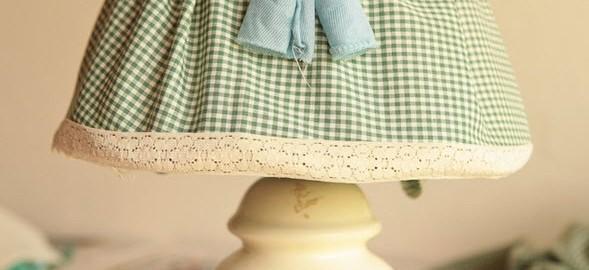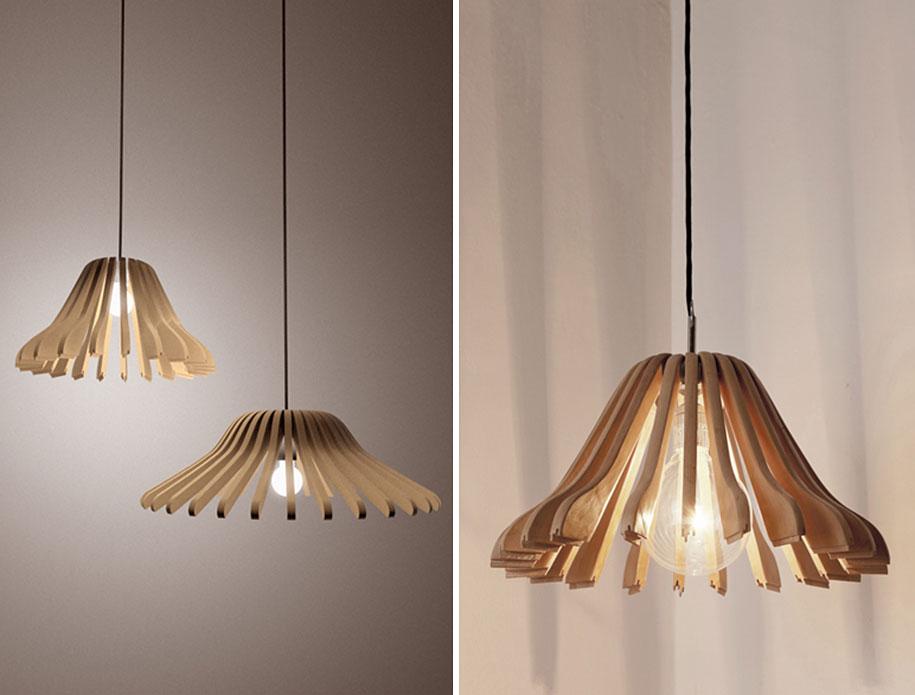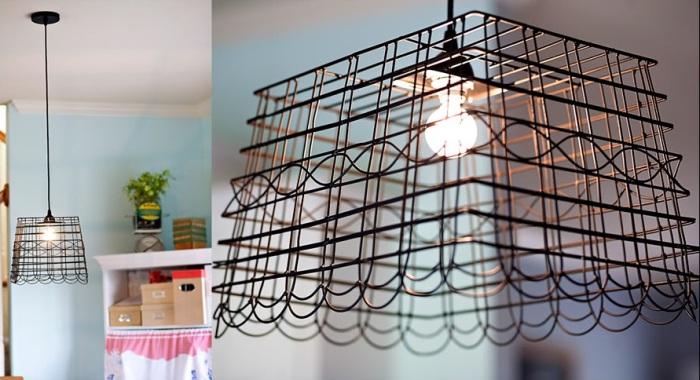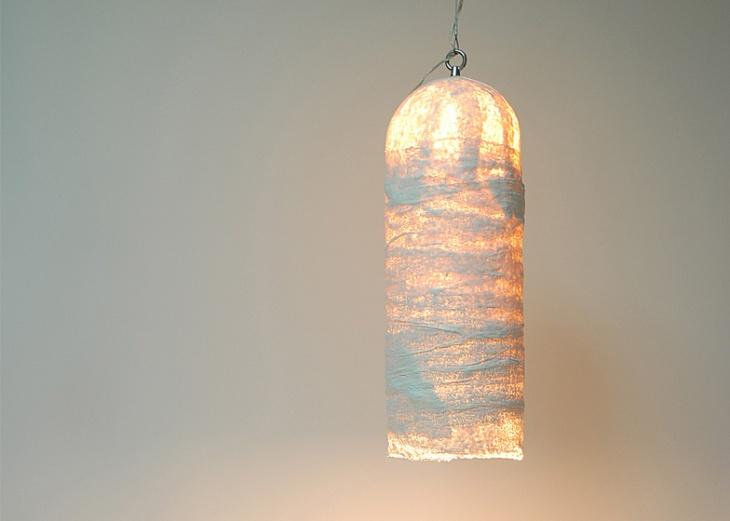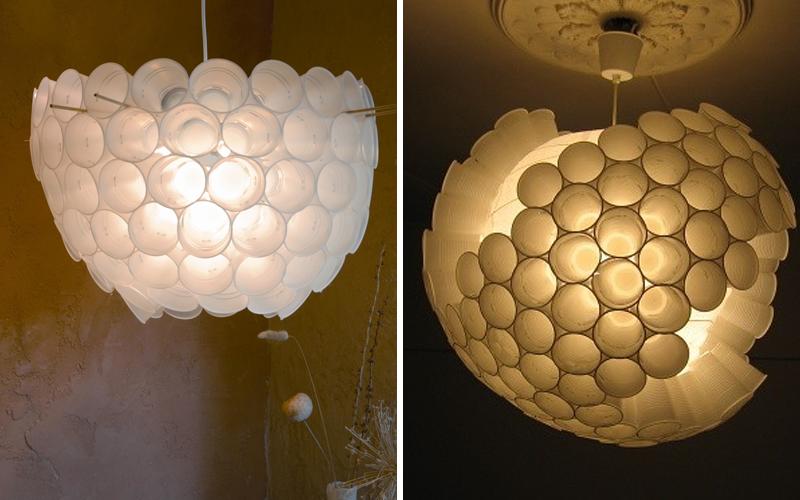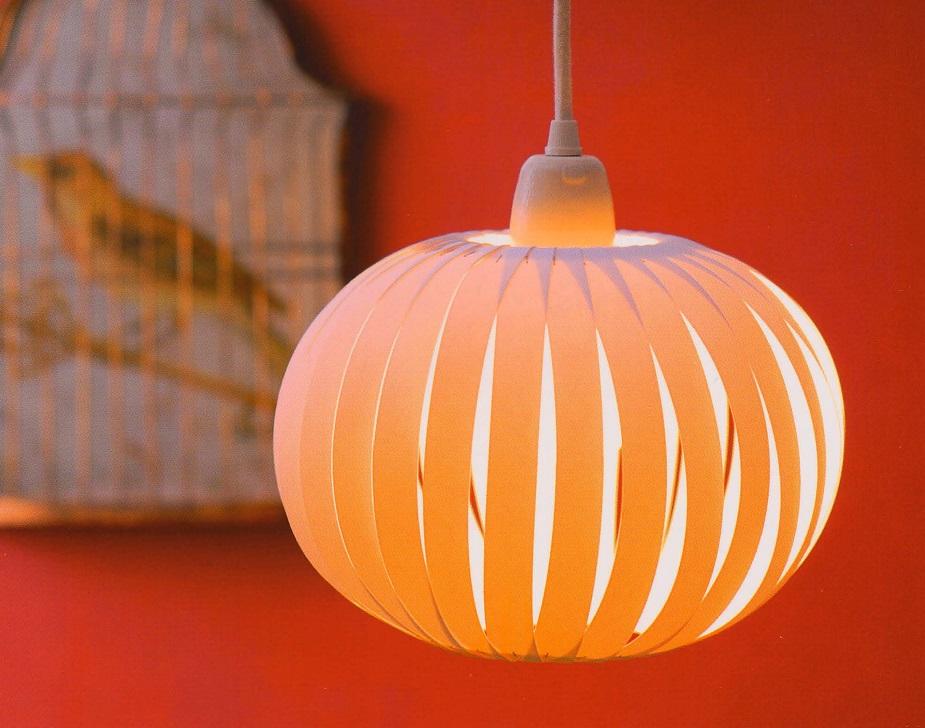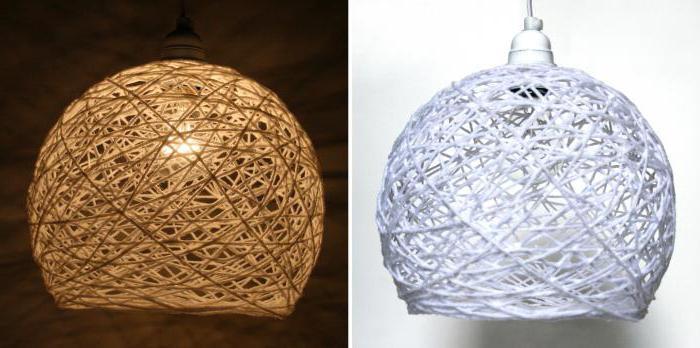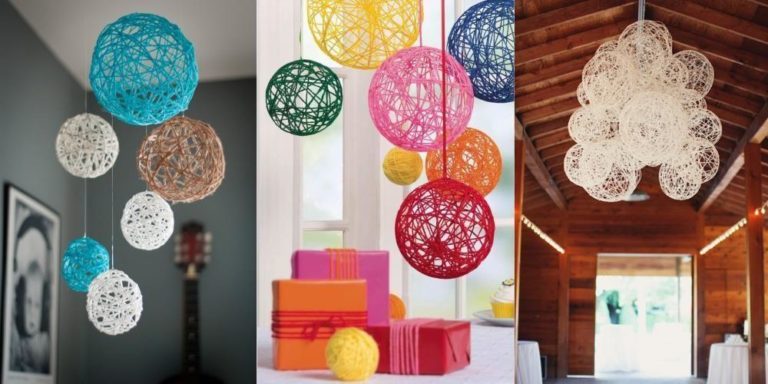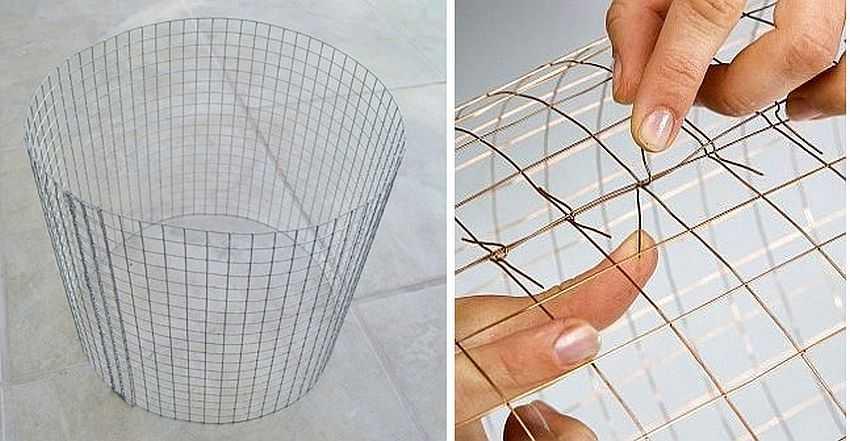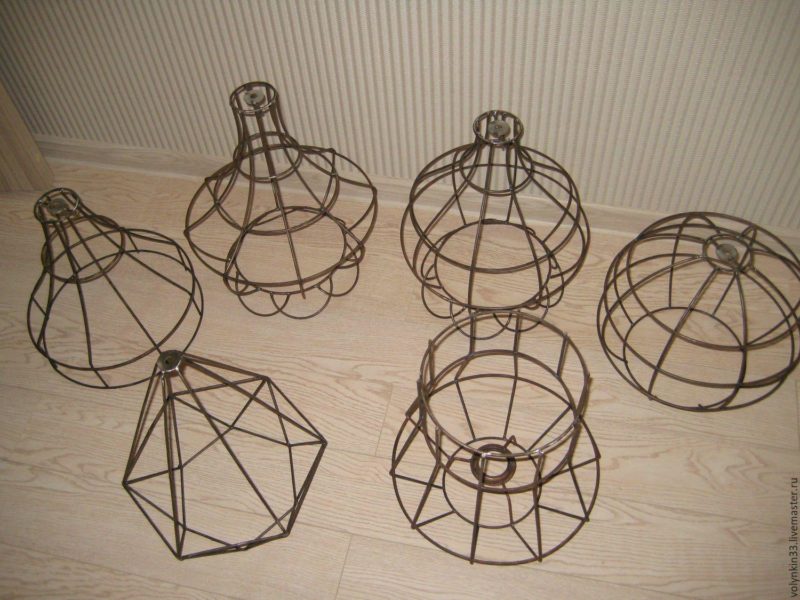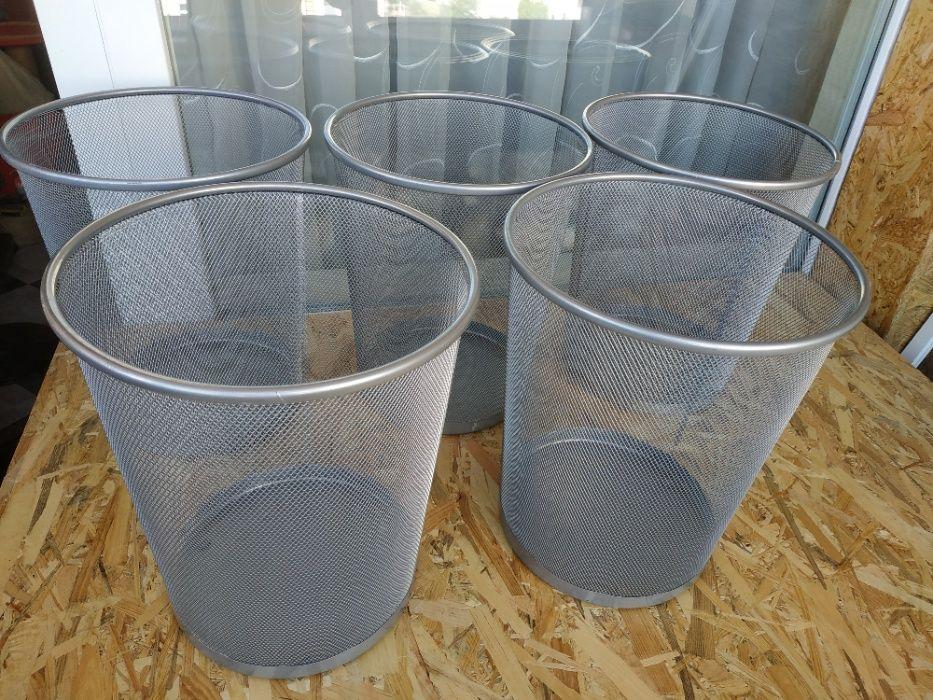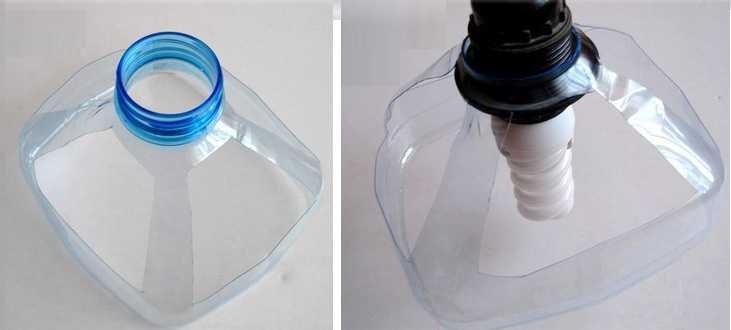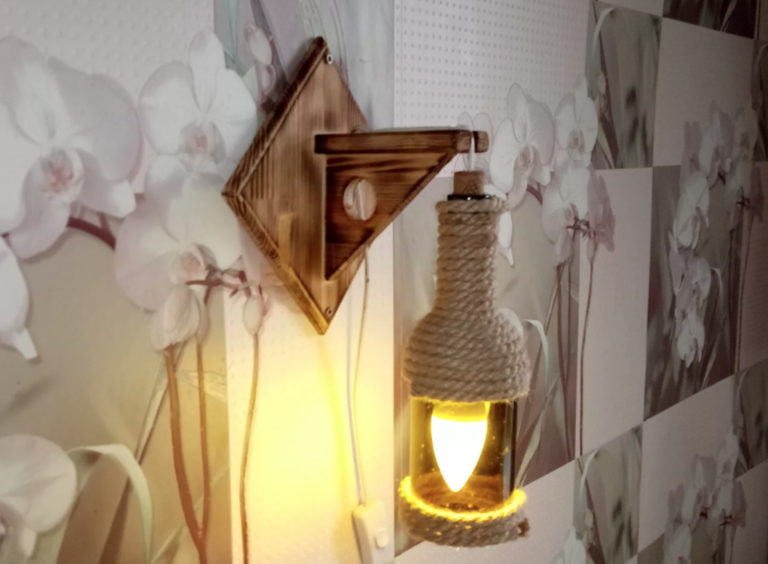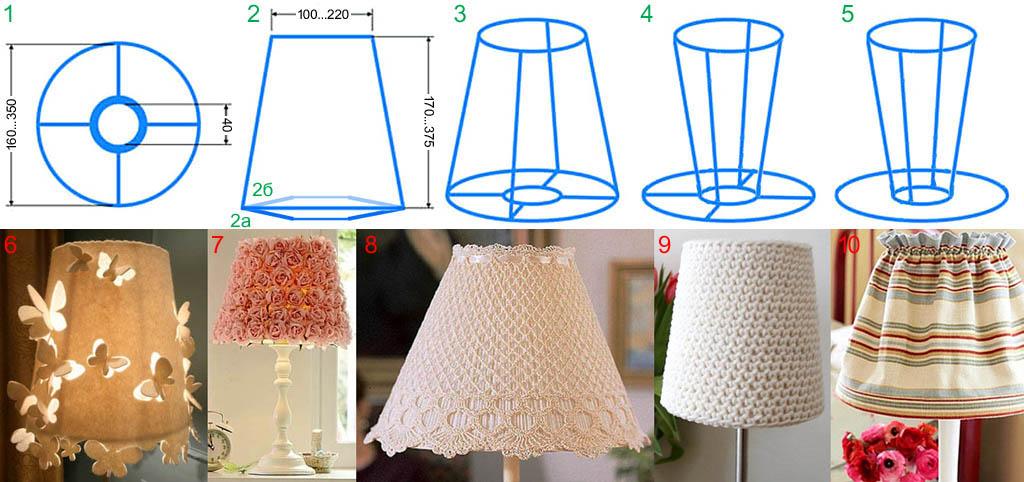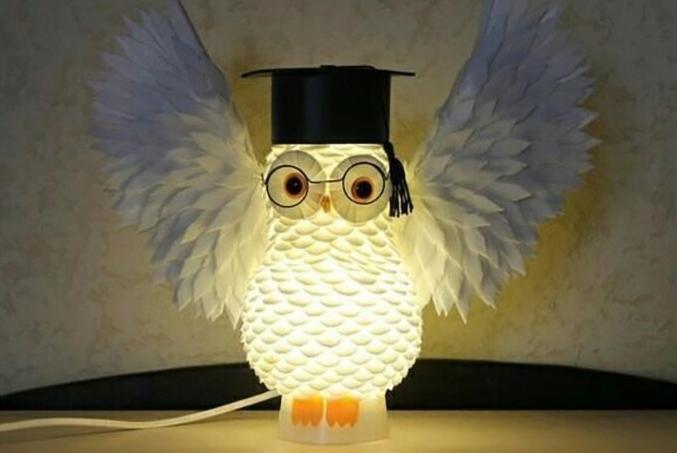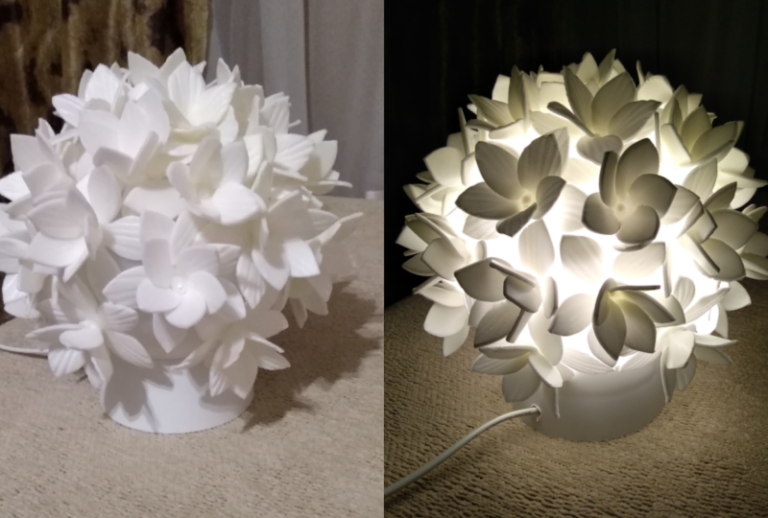Step by step instructions on how to make a lampshade with your own hands
To update your home and equip it with a convenient source of light, many people decide to make a lampshade with their own hands. For this purpose, wire, frames and even plastic bottles are used. Before proceeding to work, it is necessary to study the possible options, choose the best one and read the instructions.
What is a lampshade and what is it for
Once the light from torches was too bright, the same disadvantages were in kerosene lamps. Therefore, the designs of devices were equipped with metal flaps that dimmed the brightness of the light.
Over time, the fire was replaced by electric light bulbs, and metal flaps by different materials: cloth, glass, plastic and wood. The second function of the lampshade appeared - decoration of the interior.
Types of lampshades
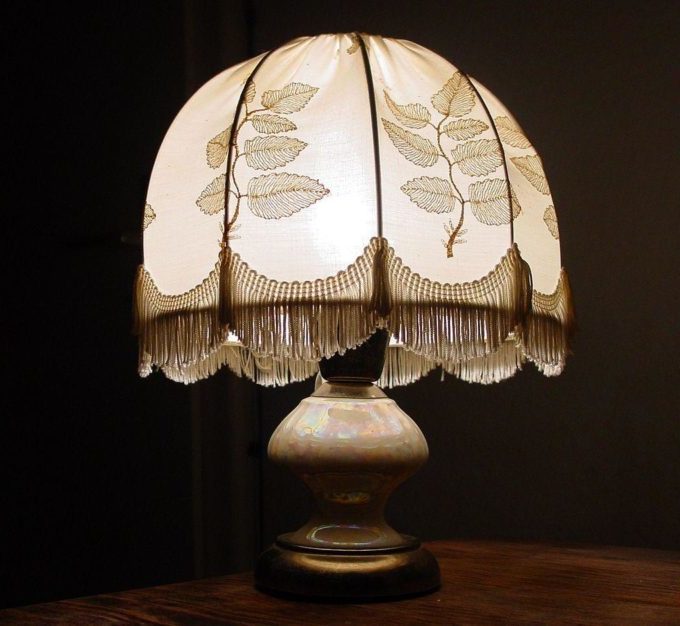
Lampshades vary in size, mounting method, design, colors and materials. There are also two main types by design: products with a special frame, frameless lampshades.
Frame
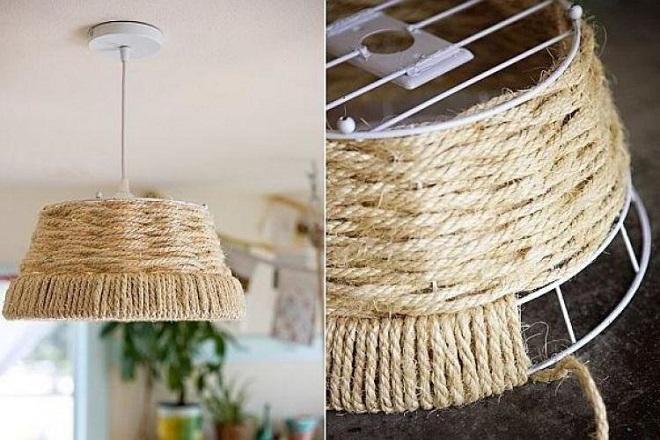
For such a lamp shade, you must first make a frame, for example, from wire, and then over it stretch fabric or other material. The advantages of the method in the possibility of creating almost any shape.
An additional design feature of the frame lampshade is that the distance between the lamp and the lamp material will already be clear at the design stage. Also framed products are durable, they retain their shape for decades.
Frameless
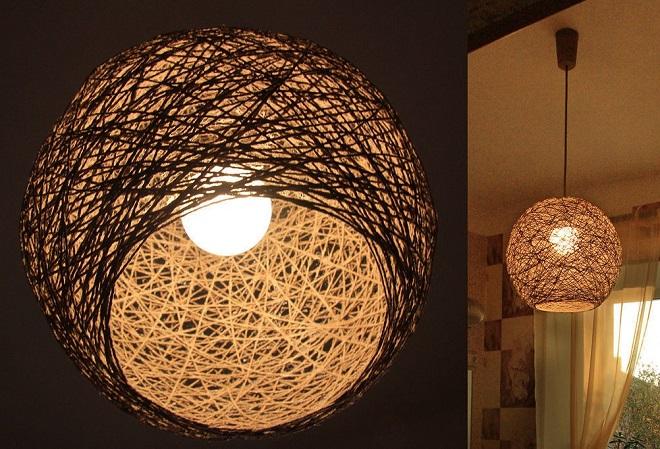
In them, the function of the frame is performed by the lampshade material. In the manufacturing process, a temporary base is made, such as an inflatable balloon, on which jute with glue or any other material is applied, after drying the temporary base is removed.
With this method it is easier to create circular lampshades. Knitting yarns can be used as the basic material.
Materials
For the lampshade
A lampshade for a floor lamp or suspended structures is a product for which a variety of components can be used. For familiarity, it is useful to study a list of the most popular:
- Textiles. Fabric is only used for framed options. There are several points about the choice, such as composition: it is best to use linen or cotton, but synthetic fabrics can melt and lose their shape and color from heat. Another problem with textiles is the attraction of dust, it can be slightly reduced by treating it with water-repellent sprays.Using fabric as a finishing layer.
- Wood. Used for a sconce or table lamp. Branches or even chopsticks can be used. They are laid in a pile on the previously formed body. The strength of wood allows you to make frameless versions from small boards or slats.Decor made of wooden hanger halves.
- Metal. For chandeliers, they often make a completely closed version of the lampshade, which allows you to direct the light downward. There are also frame-type options, where only the frame is made of metal, painted in the desired light. The loft style option is especially popular.Metal basket for the lamp.
- Gypsum. A good material for frameless bases. Pieces of bandage soaked in gypsum mortar are applied to the temporary body. The result is unevenly shaped bases. They can be left that way, or sanded down with sandpaper.Gypsum products are suitable for antique style.
- Plastic. There are many ideas for lampshades made of plastic. You can use pre-made products in the form of plastic spoons, cut elements of fancy shapes from bottles. Another way is to use a large bottle as the body, which is later painted or decorated with other materials.Lights from plastic cups.
- Paper. An affordable material for a lampshade. Paper products of different densities are used, from parchment paper to cardboard. It is also possible to make a cap in the technique of papier-mâché.Paper decoration in the form of a pumpkin.
- Thread. From threads, you can make a frameless plafond for a round shaped light fixture. To do this, the balloon is wrapped with thread or rope soaked in glue, and after drying, it is punched and removed.Hood of thread.
Making a lampshade is not limited to a list of seven materials, in fact, you can use anything. The main thing is that this material holds its shape or lies well on the frame. It can be beads, various costume jewelry, cones and so on.
Another interesting way is to use things not designed for lamps. So the lampshade can be a kitchen grater, a mesh bucket or a muffin tin.
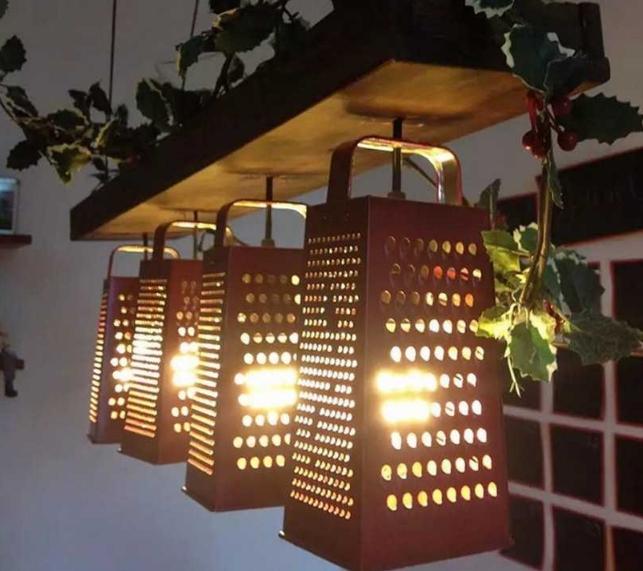
To make a frame.
If a frame lampshade is chosen, it is important to start by figuring out what materials are used for the base. It can be both ready-made products, as well as homemade designs:
- Wire mesh. Inexpensive and simple material, which will turn out a homemade cylindrical lampshade for a chandelier or floor lamp. It is important to make a cut of the mesh so that there remain small protruding pieces of wire, which will act as a fixation ring.Creating a cylindrical shape out of wire mesh.
- Application of wire. If you are not satisfied with the cylindrical shape, you can create the desired one from aluminum or steel wire. More wire cutters and pliers will be needed for the job.A variety of wire forms for the frame.
- Bucket for office waste. The design of the desired shape made of steel. There are cylindrical, rectangular and other shapes. You just need to make a cutout for the bulb and trim the top if the bucket is too big.Office garbage cans are a ready option for a light bulb.
- A five-liter plastic bottle. You just need to cut off the right part of the bottle. Even the neck of the bottle will work for some chucks and you don't have to make additional holes.Lampshade from the top of a plastic bottle.
- Other materials. You can also use plastic buckets and wooden slats for the frame.
Step-by-step instructions for the frame look
It is not difficult to make a plafond on the frame with your own hands. You only need to adhere to the step-by-step technology of doing the work.
Step 1: Preparation, choice, schemes
First you need to choose which option will be used. Personal tastes, ease of work and interior style should be taken into account when choosing. For example, paper is not quite suitable for the classic style, and burnt wood for high-tech.
Also, at the first stage, you need to make a diagram of the frame. On it, you should mark all the elements and dimensions.
Step 2: Making the frame
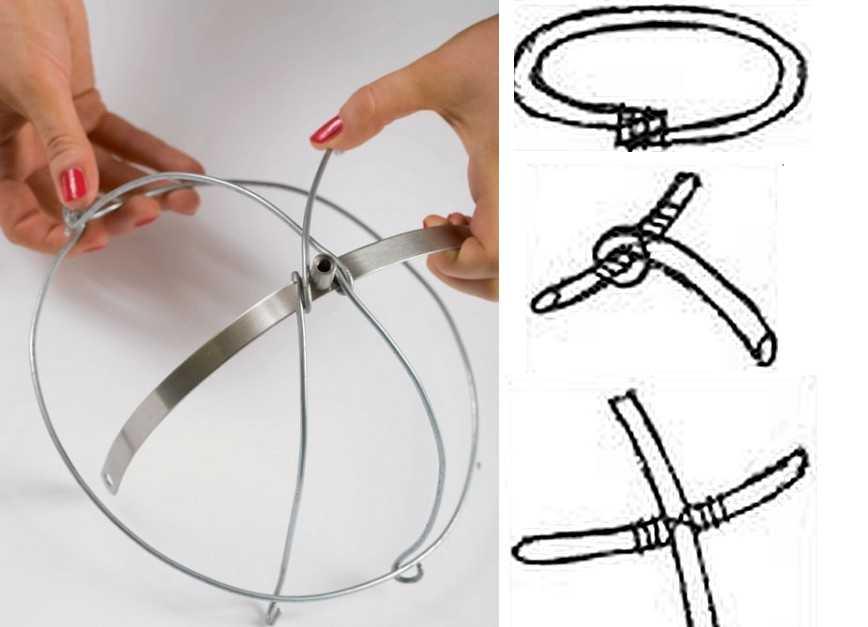
According to the previously prepared scheme, the wire of the required size is cut. The simplest option - two rings, where the smaller is installed at the top, and larger - at the bottom, between them they are fastened with straight pieces of wire. If a more interesting form is needed, then the wheels can be made even three or four. The elements are fastened by hook-and-loop bends.
Step 3: Stretching the finishing material
One of the most popular materials is textile. But first you need to construct a blank of cardboard, which wraps a wire frame, the product is trimmed to the desired shape. The resulting blank is spread out on the fabric, and it is cut according to its contour. When the desired piece of fabric is cut out, you can twist the edge and stitch with a sewing machine.
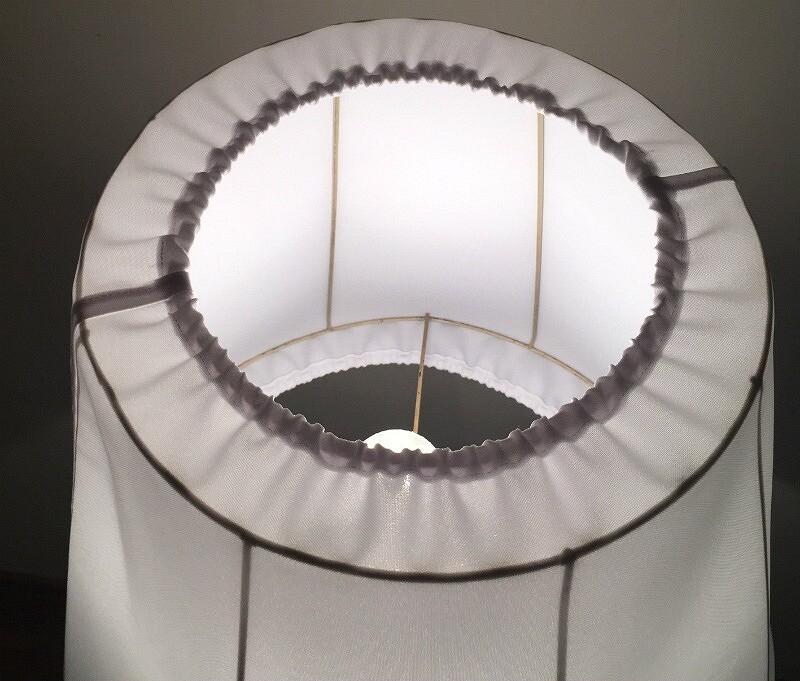
Step 4: Finishing the edges
If you were not able to process the edges with a sewing machine, a wire frame is pulled around the fabric. Everything is fixed with glue. The edging is also tucked and glued to the inside.
Step 5: Decoration
You can paint the finished product in different colors, glue cardboard or wooden figures on the inside, make drawings.
Decorating fabric structures
The simplest are single-colored fabric lampshades. But there are additional possibilities for decoration.
Provincial style.
Distinguished by the use of pastel colors, checkered patterns, lace. For decoration, you can cut a strip of fabric with which to wrap the top and additionally tie a bow. Another strip can be wrapped around the bottom and fringe attached to it.
Fabric flowers
You can make small fabric flowers, with which to decorate the bottom of the lampshade in a circle. If you have the desire and patience, florets can cover the entire body of the product.
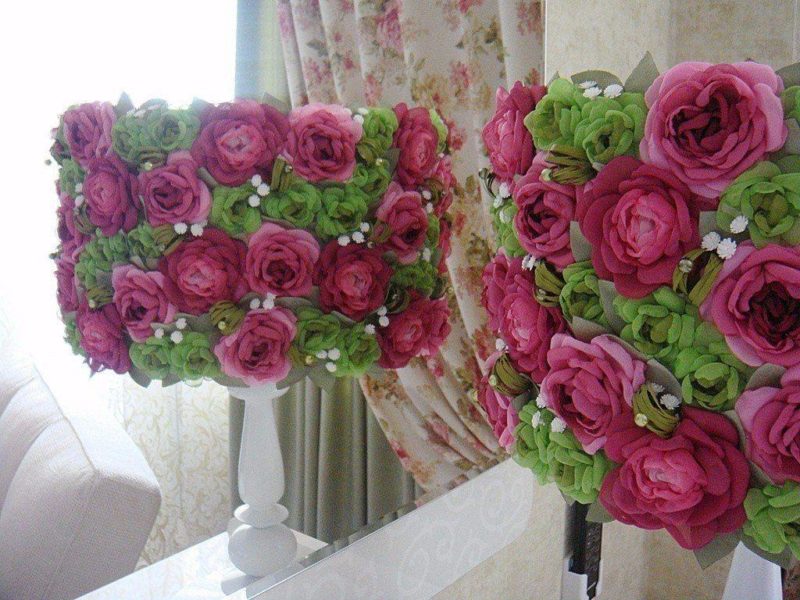
Pieces of .
The use of pieces of different fabrics provides an interesting result. You need to take a monochrome, preferably white fabric for the base, and on it sew scraps. They can be in the form of squares, horizontal, vertical or diagonal stripes. You can also use non-standard geometric shapes.
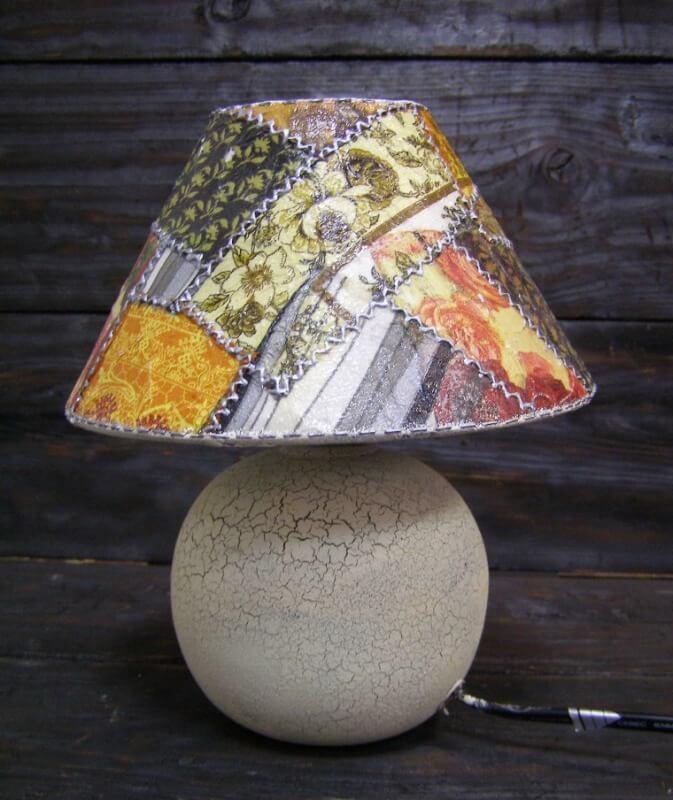
Unusual materials
The decor of the lampshade is limited only by the imagination of the master. For the plafond can be used different fabrics: burlap, denim, lace napkins. Additionally, you can decorate the surface with sewn buttons, pockets, bows.
Frameless lampshade variants
Frameless lampshades are well suited for suspended structures. They are lightweight and have an unusual appearance. For their manufacture different materials are used.
Knitted napkins
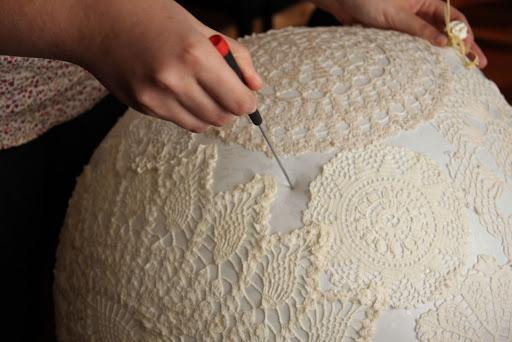
Need: an inflatable balloon, glue, crocheted napkins, the neck from a plastic bottle. Napkins are glued to a flat surface, then the entire composition is moved to the balloon. The neck of the bottle is used to fix the cartridge. At the end, the balloon is blown off.
Master Class: Plafond for a chandelier made of toilet paper.
Weaving with clothesline
For the manufacture we need: a ball, clothesline, glue. The method of weaving allows you to get the desired shape and patterns, weave the rope around the ball, giving shape to the future lampshade. Additionally, you can treat the product with glue, it will fix the shape.
Video: 5 self-makes of clothespins.
The use of thread
To make it, you need: a balloon, thread, PVA glue, the neck of the bottle for the cartridge. Around the inflated balloon is wrapped soaked in glue thread. After the glue dries, the balloon can be blown away. The density and translucency will depend on the number of layers of threads.
Lampshade made of wicker
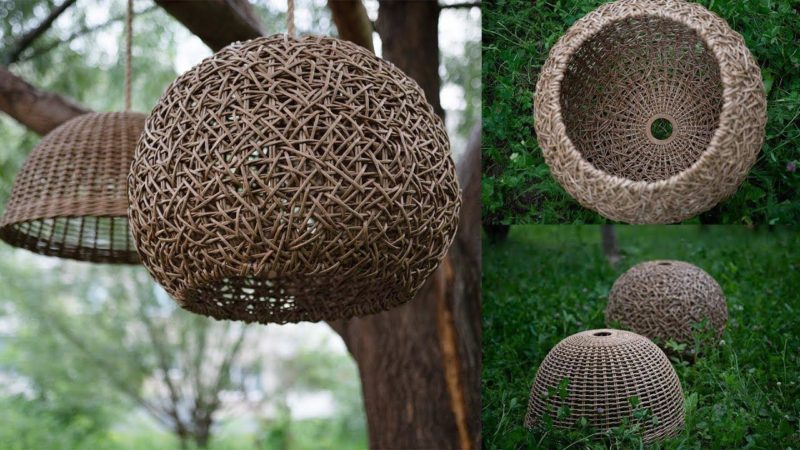
Vine is a strong material with good flexibility, so it is possible to make a lampshade without a base in the form of an inflatable balloon. The method of weaving is used, which allows you to create almost any shape.
Topical video.
Rules of operation of handicrafts
Self-made products that work with electricity are not always as safe as manufactured products. Therefore, when making and operating it is necessary to adhere to such rules:
- The light bulb should not touch the frame materials and coating. It should always be kept at a distance, even if the materials are not flammable.
- Incandescent bulbs with flammable materials should not be used. Such lighting elements are not suitable for wooden, paper and fabric lampshades.
- It is better to choose LED lamps with a ceramic or metal base. They are economical, practically do not heat up, and last longer.
- Do not install homemade lighting fixtures in rooms with high humidity. This rule is important because of the risk of a short circuit when in contact with water.
- After installation and the first turn on, you need to observe the design for a while. If the materials get hot, it is better to change the bulb to a less powerful one.
Adhering to these rules, it will be possible to make not only a beautiful, but also a safe design for the lamp, table lamp or floor lamp.
